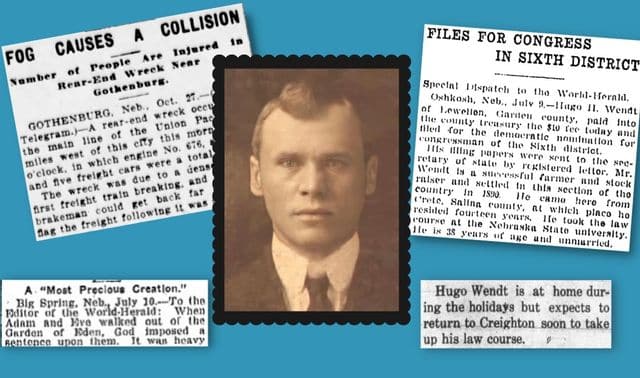Sign up for the Family Tree Newsletter Plus, you’ll receive our 10 Essential Genealogy Research Forms PDF as a special thank you!
Get Your Free Genealogy Forms
"*" indicates required fields

So much of a genealogist’s time is spent looking for records. When you finally find a record with your ancestor’s name on it, you probably do a little happy dance (it’s OK, we won’t tell anyone). But when your dance is over, what comes next? What do you do once you’ve found that record? How do you even know you’ve found the right person? Suppose the person named in the record is actually someone else’s ancestor, who happens to have the same name as your third-great-grandfathers name, be the same age and live in the same place. Or suppose this is your ancestor, except this record says his mother’s name is different from what you thought.
The answer to these questions—which also happens to be the next step in your research once you’ve located any record—is analysis and correlation. Old records give you a lot of information, but the only way to use that information to better understand your ancestor is to judge the reliability of the record, evaluate the details it contains, and compare it to other sources. These measures will help you get the most out of the records you find, resolve conflicting information, and most important, make sure you’re tracing the right family. Let’s put them into practice as we examine the best approach to common, confusing genealogy research cases.
The Meagher Family: The Case of the Surname Spelling Disaster
Your research list probably has several surnames that seem unusually subject to misspelling. Varying versions of names in old records can leave you in doubt as to whether you’ve found your family or someone else’s. The key is to look for other details that are consistent across records. You might find it helpful to create a chart with columns to record the date, names, address and other points of comparison from each record. You can see the one we’ve set up for this case below.
Background: Patrick Meagher (whose last name was probably pronounced “Mayer”) died in Baltimore, Md., sometime around 1827 to 1829. He left a widow, Mary, and several children. When Mary died about 1842, her heirs were sons Thomas, Joseph and John Meagher, and daughter Margaret.
Problem: The surname Meagher is spelled numerous ways, making it difficult to locate information about Patrick, Mary and their children. Is each record that seems to be about this family really about them?
Process: Any time you locate a record containing your ancestor’s name, you have to be sure that it actually pertains to your ancestor, and not to someone else. The only way to accomplish this is to compare all the information found in each record. Inconsistent name spellings and the use of given and nicknames mean you can’t rely on a name alone to represent a unique individual.
Patrick appears in just two records:
- the 1820 US census (which names only heads of household) in Baltimore as Patrick Mahar
- the 1827 Baltimore city directory as Patrick Magee, laborer, residing at “Union N side E of Penn Ave.”
In 1829, Mrs. Mary Meagher appears in the Baltimore city directory living at “Union st E of Penn Ave.” The term “Mrs.” in city directories usually designates a widow (an unemployed married woman wouldn’t ordinarily be listed). Later records provide more spellings, which you can view in the chart on the next page.
In the 1840 census, “Mrs. Maha” and son John Maha are listed a few lines away from another son, Joseph Makey. In an accounting of Mary Meagher’s estate, her son John Meagher, the estate administrator, names heirs John, Thomas, Joseph and Margaret, wife of Elias Hall. The record of Margaret’s 1819 marriage to Elias Hall in Baltimore County gives her surname as Maher or Maker. John’s 1833 marriage record to Julia Ann Bader uses the name John Maghar.
Conclusion: The record comparison chart on the opposite page makes it clear: Despite the disparate spellings of the surname in all these records, the address of Patrick, Mary and John stays the same. The family didn’t move in 20 years, and that piece of information gives us the necessary support that these records—and others still—all refer to the same family.
James Williams: The Case of the All-Too-Common Name
If your ancestor has a common name—and you have precious little other information to go on—it can be difficult to pick out the right person in genealogical records. Viewing a variety of records as a whole can help, and recording their details in a timeline lets you keep track of them. Here, I combined census information with careful year-by-year searching in city directories to discover identifying details about James Williams.
Background: James Williams died in Baltimore, Md., Feb. 15, 1898, at age 40, giving him a birth year of about 1858. His death certificate doesn’t name his parents. The 1880 federal census identifies more than a dozen African American men named James Williams living in Baltimore.
Problem: James Williams is a common name. Many men with this name appear in the city during this particular James Williams’ lifetime. How can we identify our James Williams’ parents?
Process: James Williams’ death certificate indicates he lived at 1101 Raborg Street. An examination of the 1898 Baltimore city directory reveals 32 James Williamses marked with an asterisk that designated these men as “colored.” One of them is “Jas A.” Williams, lab” (laborer), with a residence at 1101 Raborg—the same address as our 1898 decedent. Looking at the 1899 city directory provides confirmation: There’s no James A. Williams at 1101 Raborg.
The city directory provides more details about the individual in question: First, a name. We already knew the first name James and the last name Williams, but we now have a middle initial, A. We also have an occupation, though granted, not a particularly informative one—what kind of laborer was he? Finally, we have a street address.
City directories are often published annually, and this was the case in Baltimore during the years of interest. Searching through earlier directories, it’s uncertain whether James A. Williams appears in Baltimore from 1892 through 1897. But going all the way back to 1891 reveals a “Jas Williams, lab,” living just down the street at 1015 Raborg. Jas is an abbreviation for James. Directories of 1889 and 1890 call this man Jas A. Williams. The middle initial is an important detail that helps to corroborate the identification.
In 1888, Jas Williams of 1015 Raborg is a “shucker” (see below). Shucking oysters was a common occupation for African American men in Baltimore at the time. This new occupation follows James A. Williams earlier through other addresses:
- 1886: 9 Chesnut
- 1883: 38 Chesnut
- 1881, 1882 and 1884: 196 Hamburg
The 1880 federal census is the first to include street addresses, with street names running vertically on the left side of the schedule and house numbers in the left-hand columns. A 23-year-old man (born about 1857) named James A. Williams lived in Baltimore at “186 S. S. Hamburg St.,” with his mother Patience Williams. Here we have the same name, including the middle initial; the right age; and a street address very close to the one in the 1881 through 1884 directories. We’ve found James, with his mother (happy dance time!).
But where was James’ father? Again, we move back in the records, this time to the 1870 federal census. James A. Williams, age 13 (born about 1857), lived in the household of George Williams and his apparent wife, Patience (“apparent” because relationships to the head of household weren’t stated in 1870).
In 1860, James Williams, age 2 (born about 1858), lived in the household of “Geo H.” (an abbreviation for George) and Patience Williams. George Henry Williams and Patience, with their older children, also appear in Baltimore in the 1850 census, before James was born.
Conclusion: Using city directories and census records together, we’ve shown that James Williams, who died Feb. 15, 1898, in Baltimore was James A. Williams, the son of George Henry and Patience Williams. Additional research in city directories should support this conclusion, as might research in newspapers, church records, and possibly probate records.
Mary or Elisabeth Williams: The Case of Two Mothers’ Names
Finding records that give conflicting information about an ancestor can really burst your genealogy bubble. But if you understand whether a record contains primary information (provided by those with direct knowledge of the event) or secondary information (by informants not present when the events occurred), you’ll have a better handle on which document is more likely to be correct.
Background: George W. Williams died Oct. 12, 1875, in Taylor County, W.Va. His death record, a locally kept register shown on the opposite page, identifies his place of birth as “Prince George” County, Md. (the county name is actually Prince George’s). His parents are listed as Joseph and Mary Williams.
But George’s 1871 marriage record to Christine See, his second wife, identifies his parents as Joseph and Elisabeth Williams. The 1870 US census in Taylor County reports his age as 44 years, born in Maryland. The 1860 census for this county (when it was part of Virginia) includes Harriet (likely his wife, though this census doesn’t state relationships), also born in Maryland. Both records name children born in Pennsylvania.
Problem: Who were George’s parents? Two records naming them provide conflicting information.
Process: When multiple records provide inconsistent information, researchers need to resolve the conflict. The best way to do this is to consider the quality of the information provided in the records and ask which record provides more-reliable information.
In 1871, George W. Williams would himself be present when he applied for his marriage license and recorded his marriage bond. In all likelihood, George himself provided the information about his parents. The informant for George’s 1875 death record is also identified: Christine B. Williams, his second wife. Would Christine be capable of providing accurate information?
We can’t know how long George knew Christine, but we can be certain that she wasn’t present at the time of his birth. The information she provides regarding the identities of his parents would’ve been relayed to her by someone else, possibly George or one of his children. Of course, memories can be faulty, especially in times of grief following the death of a loved one.
Considering these possible sources of error for the 1875 death record, we also can evaluate how accurate the 1871 marriage record might be. Of course it’s possible that George’s parents died without his knowing them, but it’s also fair to presume that he, like most other people, knew his parents.
Conclusion: All of this analysis leads to the conclusion that the 1871 marriage record provides a more accurate identification of George’s parents than his 1875 death record. Although George W. Williams’ 1875 death record names his parents as Joseph and Mary Williams, his 1871 marriage record names them, more reliably, as Joseph and Elisabeth Williams. Future research in Maryland and possibly Pennsylvania records should pursue corroborating evidence naming George as a son of Joseph Williams and his wife Elisabeth.
George Barris: The Case of the Conflicting Birthplaces
A second strategy to help you resolve conflicting records, which you could use in addition to evaluating the reliability of your sources, is to research as many records as possible and compare what they tell you. Information that appears consistent across multiple types of records is more likely to be accurate. This is another case where it’s helpful to use a chart to compare details found in records.
Background: In 1880, George “Barris” lived in Mount Morris, Ogle County, Ill. That year’s federal census states he was 24 years old and born in Pennsylvania. Both of George’s parents also were reportedly born in Pennsylvania, as were his wife Ida, age 22, and eldest son “Isacca,” age 5. George and Ida’s two younger children, daughters Savilla, 3, and “Berntia,” 1, were born in Illinois.
The 1900 census reports that George Barris, age 45 years, was born in Maryland. This time, his father is reported to be born in England, while his mother was born in Germany. George’s wife Ida, age 42, was born in Pennsylvania, and each of his five children then living with them was born in Illinois.
Problem: No record by itself appears to identify the parents of George Barris. Records disagree about George’s birthplace and the birthplaces of his parents.
Process: The places of birth of both George and his parents as reported in the 1880 and 1900 censuses disagree. Looking at other records, though, provides more information (the birthplace details are summarized in the chart below):
- In 1870, “George W. Barows,” age 14 years, lived as a farmhand in the household of Nicholas and Barbara Martin in Hagerstown, Washington County, Md. He was reportedly born in Maryland. “Barows” is phonetically similar to “Barris” from later census records. Could this be George Barris?
- In 1860, George “Barrow,” age 4, lives in the household of his apparent parents (remember, this census doesn’t specify how household members are related) Philip and Elizabeth Barrow, in Baltimore. George was reportedly born in Maryland. Philip, age 39 years, a rigger (who works with ships’ rigging) by trade, was reportedly born in Maine. Elizabeth, age 36, was reportedly born in “Hesses”—almost certainly Hesse, a German state.
All four of these census records, from 1860 through 1900, are of equal reliability. None of the records tells us who provided the information to the census taker, so all are equally prone to misinformation. Both the 1860 and 1870 censuses, though, report that George was born in Maryland, agreeing with the 1900 census. In 1860, Elizabeth Barrow, George’s apparent mother, was born in Germany, also as reported in 1900. But the 1860 census offers a further conflict in reporting that Philip Barrow, George’s apparent father, was born in Maine, rather than England. But Maine lies in New England—a potential explanation for mistaken information in 1900. With this corroborating detail, the 1900 federal census gains additional credibility.
Even though George “Barris” was born after 1850, Philip and Elizabeth’s apparent son Peter, age 15 years in 1860, suggests that they were married before 1850. So we know that examining the family’s 1850 census record may lend further evidence used to reconcile the conflicting information about George. In 1850, “Phillip Barrows,” age 34 years, a sailor, appears with Elizabeth, age 28 years, and Peter, age 5 years. Phillip was born in Maine, Elizabeth in Germany, and Peter in “Mareland.” The family lived in Camden, Waldo County, Maine.
Again, this 1850 census record is just as prone to error as the other four censuses. Let’s take another look at these records, though. George’s surname is spelled differently, but Barrow(s) and Barris sound alike. The ages and other points of information agree, for the most part. George’s place of birth is recorded as Maryland in 1860, 1870 and 1900; only the 1880 census disagrees. In 1850, 1860, 1870 and 1900, the place of birth of George’s apparent mother Elizabeth is recorded as Germany; again, only the 1880 census disagrees. The 1850 and 1860 censuses report that Phillip Barrows was born in Maine and their apparent eldest son Peter was born in Maryland. Though the 1870 census doesn’t provide information on either parent, the 1900 census states that George’s father was born in England.
The repetition of facts alone doesn’t provide a resolution to the conflicting birthplace information. But when you consider the information that agrees among the five records as a whole, it certainly appears that you can form at least a tentative hypothesis.
Conclusion: The 1880 federal census disagrees almost entirely with all other known and suspected records concerning the place of birth of George Barrows/Barris. Discounting this record, however, we can conclude that George was most likely born in Maryland about 1856, and that his parents were most likely Philip Barrows and Elizabeth (whose maiden name is unknown as yet). Philip was born in Maine, and Elizabeth was born in Germany. Searching for a birth record for George in Maryland would provide more evidence to confirm that Philip and Elizabeth were George’s parents.
Records are great when you can find them, but only rarely will you find that “magic record” that completely solves a genealogy problem on its own. Even when it seems to, how can you trust it? Analyzing your records as a whole often reveals details not immediately evident. Comparing and correlating multiple sources helps you determine the reliability of the information you’ve collected. Combining these two processes allows you to feel more confident in the accuracy of your research.
A version of this article appeared in the October/November 2015 issue of Family Tree Magazine.
ADVERTISEMENT




